“Before I become personally involved in a project, I look for two essential qualities. First, the cause must be something I feel passionate about. And second, I want to make a real difference by supporting that cause … and by encouraging others to do the same.”
Over the past 35 years, Iris & B. Gerald Cantor Foundation grants have made substantial differences in peoples’ lives. By investing in key institutions, we have made it possible for them to make tough and strategic decisions. For example —
When Mr. and Mrs. Cantor were introduced to Stanford University, they were not only impressed by the level of academic achievement for which the University is universally acknowledged, they were also taken with the beauty of the campus. Mr. Cantor once reminisced about his first visit there, in 1973:
“I had an immediate affinity with the place; it had everything, a beautiful nineteenth-century building with a rotunda, which dates from Rodin’s lifetime, and large exterior space for a sculpture garden, which I paced off…. It had a built-in Rodin scholar of worldwide reputation in professor (Albert) Elsen…. Furthermore, I wanted my collection to be exposed not only to the public but to students and Rodin scholars.”
In 1974 the B.G. Cantor Art Foundation (the predecessor to the Iris & B. Gerald Cantor Foundation) gave Stanford University eighty-nine Rodin sculptures to be placed throughout the campus. At the time, it was the largest donation of sculpture ever made to a university art museum. This was followed during the next 20 years by many more donations of artworks and Rodin-related items, as well as by funds to support museum programs and, most importantly, fellowships for graduate students studying Rodin. Rodin studies became central to Stanford’s art history curriculum.
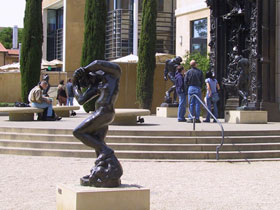
The B. Gerald Cantor Sculpture Garden at the Iris and B. Gerald Cantor Center for Visual Arts at Stanford University
When the Loma Prieta earthquake hit Northern California in 1989, the severely damaged Stanford University Art Museum was forced to close. The Cantor Foundation rescued the institution with a significant grant for rebuilding. When the Museum reopened ten years later, it was re-named the “Iris & B. Gerald Cantor Center for Visual Arts” in acknowledgement of this support.
More recently, with our help, the Cantor Center published a catalogue to accompany its 2011 exhibition Rodin and America. Scholarly exhibition catalogues have always been of great interest to the Foundation, as they perpetuate what otherwise would be ephemeral.

Using state-of-the-art equipment at the Iris Cantor Breast Imaging Center at UCLA
Mrs. Cantor’s dedication to women’s health issues began when her beloved younger sister was diagnosed with breast cancer and passed away from the deadly disease. During the 1990s, Iris Cantor and the Cantor Foundation transformed clinical health care for women at the University of California’s campus in Los Angeles. At Mrs. Cantor’s urging, UCLA implemented her thoughtful ideas for three centers serving women: a center for breast imaging, a women’s health center, and a women’s health education and resource center. The Iris Cantor Center For Breast Imaging, under the direction of the Iris Cantor Professor of Breast Imaging, implemented her vision of integrating research and education with primary care. It not only welcomed women to a model facility, it also sent a mobile breast imaging center out into the community, reaching thousands of women who otherwise would not have had mammograms.
The Iris Cantor-UCLA Women’s Health Center was the first such facility that gave women immediate access to the wide arena of specialists and tests necessary to ensure good health. As Iris Cantor says, “Convenience is an incentive to good health.” Under the direction of the UCLA physician and professor who literally wrote the contemporary textbook on women’s health, the Center has flourished since its 1992 founding. Repeatedly designated a ‘Center of Excellence’ by the National Institutes of Health, it is a model for women’s care centers nationwide.
Created as an integral part of the center – because Iris Cantor believes that women who are educated about their health are healthier – is the Iris Cantor-UCLA Women’s Health Education and Resource Center. Its health education programs reach underserved populations where they reside. Most programs are collaborations with other health and social service agencies that serve economically-challenged, often non-English-speaking neighborhoods. Programs are usually multi-generational and designed to educate the entire family.
At UCLA, the Foundation has supported other areas in health care and medicine, especially research and clinical care in nephrology and digestive diseases. In addition, the Cantor Foundation has provided major grants to the University’s schools of business and fine arts.
New York-Presbyterian Hospital has also been transformed by Iris and B. Gerald Cantor and their Foundation. The Foundation has funded obstetric and gynecology facilities, an ambulatory surgery center, and renovations to the Lying-In Hospital. The Foundation also contributed generously to a series of major modernization efforts. It also has funded symposia in various areas, immunology efforts, programs about issues affecting women’s health, and professorships.
The donation that created the most excitement at New York-Presbyterian Hospital was the gift in 2000 that implemented Iris Cantor’s vision for women’s health care in New York. Building on the pioneering efforts of the Iris Cantor-UCLA Women’s Health Center, the Iris Cantor Women’s Health Center at New York-Presbyterian Hospital opened in 2002. It confirmed the new paradigm in patient care by taking into account the fact that women are busy. Thus a patient coming to the Health Center finds all necessary medical services there.
“In April 2002, the Iris Cantor Women’s Health Center at New York Presbyterian Hospital/Weill Cornell Medical Center celebrated its grand opening and today is one of the most comprehensive medical facilities for women in the world. The Center has served close to 90,000 women and men [2008] and has demonstrated Mrs. Cantor’s inspiration for the Center: Convenience is an incentive to good health.”
–Orli R. Etingin, M.D., Director, Iris Cantor Women’s Health Center
–Herbert Pardes, M.D., President & Chief Executive Officer, New York Presbyterian Hospital
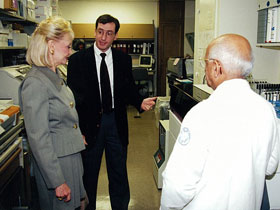
Iris Cantor at Rogosin Institute
Today, the Cantor model for clinical care for women is widely admired and emulated. And even copied close to home: in 2011 Iris Cantor personally funded the Men’s Health Center here; it follows the model of her women’s centers.
The Foundation’s support for institutions engaged primarily in medical research is also well known. The Rogosin Institute is such a place. Principally interested in kidney and cardiovascular diseases, it concurrently conducts research from the molecular-genetic level through the clinical level, provides treatment to patients, and fosters scientific and medical education. It is affiliated with New York-Presbyterian Hospital, Weill Cornell Medical College, and The Rockefeller University. The Foundation has provided funding for its Laboratory for Immunological Research in Diabetes and for its Laboratory for Clinical Research.
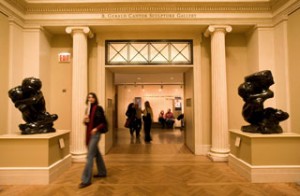
The Metropolitan Museum of Art
The Metropolitan Museum of Art has long been special to the Iris & B. Gerald Cantor Foundation, for it was here in 1945 that the sculpture of August Rodin first captivated Bernie Cantor. Through grants, gifts of works of art, and active participation on the Museum’s Board and its many committees, Mr. and Mrs. Cantor and their Foundation have contributed generously to this much-admired institution. Cantor gifts have also funded significant new gallery spaces for the Met’s extraordinary special exhibitions and wondrous permanent collection.
A highlight of a visit to The Metropolitan Museum of Art is a visit to the Cantor Roof Garden, considered by many to be the most dramatic outdoor space for sculpture in New York City. Overlooking Central Park, the Roof Garden features changing exhibitions of modern and contemporary sculpture that are both challenging and rewarding. Among the Foundation’s other gifts to the Met have been endowments for special exhibitions and publications in modern art and in European sculpture and decorative arts. These endowments has have enabled the Museum to mount extraordinary exhibitions every few years; recently these have showcased the achievements of French bronze sculptors from the 15th to 18th centuries, the Italian master Bernini, the Spanish painter El Greco, and Picasso from the Met’s own collection, an exhibition which was the Met’s most well-attended show since 2001. These exhibitions have been accompanied by important scholarly catalogues. Yet another Cantor fund at the Met has supported acquisitions of European sculpture and decorative arts.
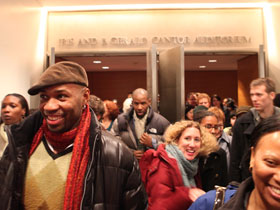
Iris and B. Gerald Cantor Auditorium at the Brooklyn Museum of Art
The Brooklyn Museum of Art has received Foundation gifts for many years. Included have been underwriting for important and diverse exhibitions, ranging from shows of paintings by French Impressionist Frederic Bazille to the architecture of Japan’s Arata Isozaki. The Foundation funded the creation of the Iris and B. Gerald Cantor Auditorium, continuing today as the site of much of the Museum’s lively public programming, thanks to a more recent grant that supported the modernization of the Auditorium’s audio-visual equipment. And most importantly, the Brooklyn Museum of Art is renowned for its encyclopedic collection of more than 1.5 million objects. Treasured among these are sixty-six Rodins, gifts from the Foundation, which are often on view in the Iris & B. Gerald Cantor Gallery or in the Cantor Rotunda. In addition, Iris Cantor, while serving as Vice President of the Museum’s Board of Trustees, worked tirelessly to secure an appropriate level of public funding for this esteemed New York museum located in the community where she was born and raised.
At NYU the Cantor Foundation has concentrated on arts and business education. In 1991, the Foundation made a generous gift to the building fund of the Stern School of Business’ Management Education Center, a dramatic way for Bernie Cantor to celebrate the city where he created his successful company and honed his highly respected management skills. The B. Gerald Cantor Boardroom was named in appreciation of this gift and his success.
Under Iris Cantor’s leadership, the Foundation has taken an avid interest in Tisch School of the Arts at NYU. With Foundation support, a 1938 Art Moderne movie palace in Tisch’s immediate neighborhood was transformed into the Iris and B. Gerald Cantor Film Center, which provides state-of-the-art lecture halls and screening facilities for student work and international film festivals. The Foundation has also created an endowed scholarship fund at Tisch, named in honor of Iris and B. Gerald Cantor, to support students of exceptional promise in creative studies.
“We are so thankful for the spirit and generosity of the Iris & B. Gerald Cantor Foundation whose transformative support directly impacts the lives of the storytellers and artists who will undoubtly shape the cultural landscape of tomorrow.”
–Mary Schmidt Campbell, Dean, Tisch School of the Arts, New York University
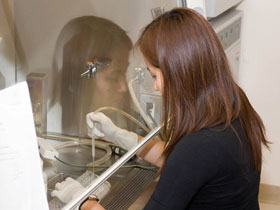
Researcher at the Discovery Eye Foundation
Since its inception, the Iris & B. Gerald Cantor Foundation has funded medical research, especially when it has concerned diabetes and its effects. The Foundation’s support for the Discovery Eye Foundation began decades ago when it provided a significant challenge grant to support cutting-edge research into diabetic retinopathy, the leading cause of blindness in people 24 to 44 years old. The Cantor Foundation established the Iris and B. Gerald Cantor Diabetic Eye Research Program and Laboratory at the Discovery Eye Foundation’s facilities at the University of California at Irvine. This lab has been responsible for important advances in eye research and treatment.
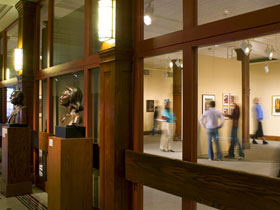
Iris and B. Gerald Cantor Art Gallery at the College of the Holy Cross
In the early 1980s, the Iris & B. Gerald Cantor Foundation supported the creation of an art gallery at the College of the Holy Cross, a small and distinguished New England college in Worcester Massachusetts. Today the Iris and B. Gerald Cantor Art Gallery is a place where interdisciplinary education thrives; faculty members from diverse fields use material culture to educate the students and the broader community. The stability of the Cantor Art Gallery was assured in 2008 when a significant Foundation grant challenged the College to increase the numbers of Gallery members and supporters and to create an endowment for staff and operating support.
For decades, the Iris & B. Gerald Cantor Foundation has supported Memorial Sloan-Kettering Cancer Center’s research into the causes, treatment, and pathology – including family genetics – of breast cancer. It has also underwritten research into lung cancer and digestive cancers. In 1989, the Foundation funded Memorial Sloan-Kettering’s Iris Cantor Center for Diagnostic Imaging and Breast Cancer; today this groundbreaking facility is a fulcrum for Memorial Sloan-Kettering’s treatment of breast cancer. The Foundation has also endowed the Iris Cantor Chair here. It is funded in honor of Dr. Sidney Winawer, renowned for his studies into the prevention and treatment of digestive cancers.
“For nearly two decades, the Foundation has been a steadfast supporter of Memorial Sloan-Kettering and its lifesaving work…. The Foundation’s commitment… to endow the Iris Cantor Chair is paving the way to new progress against digestive cancers, which together constitute the most prevalent form of the disease worldwide and the leading cause of cancer death.”
– Sidney J. Winawer, M.D., Paul Sherlock Chair, Memorial Sloan-Kettering Cancer Center
In education, a grant from the Foundation made it possible for the Alumni Association of DeWitt Clinton High School in the Bronx to create the B. Gerald Cantor Business Center in the School library. Here, with the help of student mentors, Clinton students have learned to use computers as a business tool; they have on-line access to other educational activities that prepare them for their future. Bernie Cantor was an alumni of Clinton. The Business Center plaque says “B. Gerald Cantor was always proud to say he was a Clinton man. A grateful school acknowledges one of its greatest sons.”
Ours was the leadership gift in support of an important exhibition that visited seven museums in the United States and one in France between 2010 and 2012. The exhibition, traveling under the auspices of FRAME – French Regional and American Museum Exchange – was from the Musée des Beaux-arts de Dijon and featured the most important sculptural group of 14th-century Europe. This show visited The Metropolitan Museum of Art, Los Angeles County Museum of Art, Dallas Museum of Art, Minneapolis Institute of Arts, St. Louis Art Museum, Virginia Museum of Art, and Fine Arts Museums of San Francisco, as well as Paris’ Musée du Cluny.
The first museum to exhibit the Cantor Collection of Rodin sculpture was the Los Angeles County Museum of Art. With Homage to Rodin, LACMA and Mr. Cantor began a long and significant relationship. Soon, the relationship included Iris Cantor and the Iris & B. Gerald Cantor Foundation. Beginning in 1968, the Foundation supported building programs, acquisitions, and exhibitions. It underwrote the Iris & B. Gerald Cantor Rodin Gallery, the B. Gerald Cantor Sculpture Garden, the Iris & B. Gerald Cantor Fund for acquisitions in decorative arts and sculpture, and exhibitions as varied as Gustave Caillebotte, Treasures of the Holy Land, and Sargent and Italy. The Iris & B. Gerald Cantor Foundation also supported numerous public programs and donated more than 50 works of art to LACMA, most of these important Rodins.
“Since the opening of LACMA in 1965, B. Gerald Cantor (Bernie) demonstrated a profound devotion to the arts and to the citizens of Los Angeles. In 1974 a donation of 52 Rodin sculptures established the B. Gerald Cantor Sculpture Garden, which featured Rodin’s “Monument to Balzac” as the work of art welcoming all visitors to the Museum. Bernie and his wife Iris served as trustees to the Museum and established the Iris and B. Gerald Cantor Sculpture Plaza and the Iris and B. Gerald Cantor Gallery; they have also generously funded other LACMA programs. Their tradition of philanthropy is continued today by their Foundation, led by Iris Cantor, which funds medical, educational, cultural and arts programs throughout the world.”
–Plaque on Iris and B. Gerald Cantor Sculpture Plaza, Los Angeles County Museum of Art

